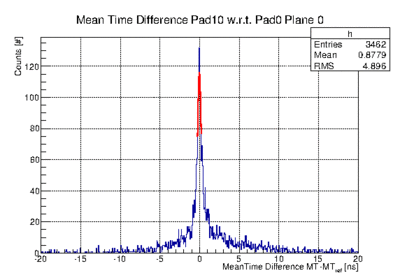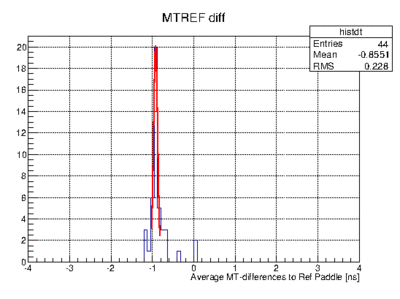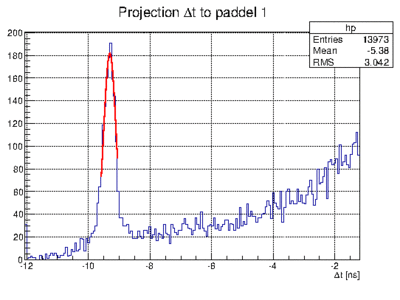First look at TOF calibration
From GlueXWiki
First Look
- first select data sample with the following conditions:
- only consider hits within 50ns of the timing peak both for ADC data and TDC data
- only consider paddles that have hits on both ends
- take care of the 6fold trigger timing shift in the TDC (24ns window)
- Do a rough determination of the walk correction by using the time in the ADC as reference.
- Do mean time comparison between different planes
- calculate MeanTime of Paddle i in plane j:

- calculate MeanTime for all Paddles n in plane k:

- For each Reference paddle in plane j:

-

- and after using the correct timing conversion of 23.4375ps/bin:
-

- Fit the meant time peak of each projection. This is the relative mean-time difference.
-
 example 1
example 1 -
 example 2
example 2 - and now a good example after using the correct timing conversion
-

- and an example where the automatic fit failed because the meantime peak is smaller than the background
-

- Do this for each paddle in the first plane as reference paddle.
- Choose one paddle in the first plane as THE REFERENCE PADDLE
- Calculate the difference between the fit results of each paddle in the first plane w.r.t. THE REFERENCE PADDLE and fit the distribution
-
 average difference of mean time to REFERENCE PADDLE
average difference of mean time to REFERENCE PADDLE - Now we have offsets for the Mean-Time for all Paddles w.r.t. THE REFERENCE PADDLE
- calculate MeanTime of Paddle i in plane j:
- Do time difference comparison of one paddle with the paddle number in the other plane
- calculate time difference:

- plot this time difference vs. paddle number of paddles that got hit in the other plane
-

- again look at each projection and fit the
 peak
peak -

 example fits
example fits - now one can also plot the fit results as a function of paddle number. The inverse slope is the speed module paddle pitch
-

- one can also plot the difference between symmetric paddles around the beam hole

-
 choose the intersection at zero for the time difference offset
choose the intersection at zero for the time difference offset
- calculate time difference:
- Now we have offsets for time difference (TD) and mean time (MT)
- offset for the left pmt:

- offset for the right pmt:

- as a bonus we get the effective speed of light for each paddle.
- offset for the left pmt:


